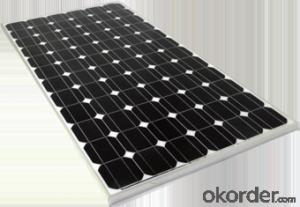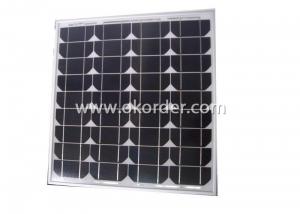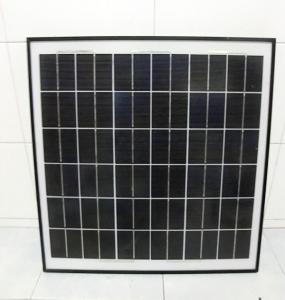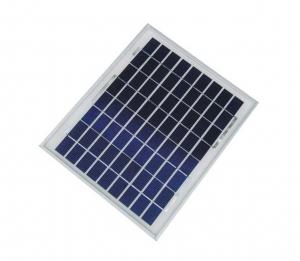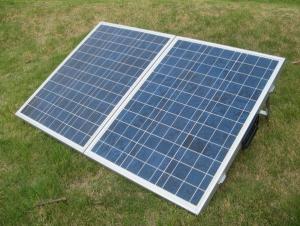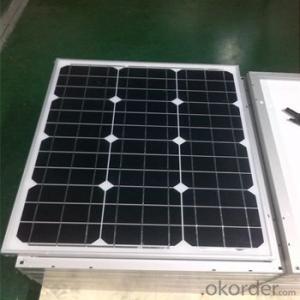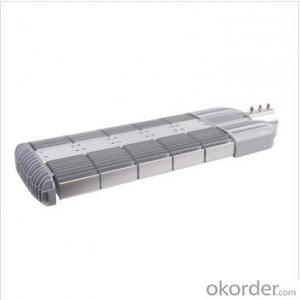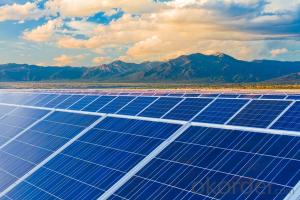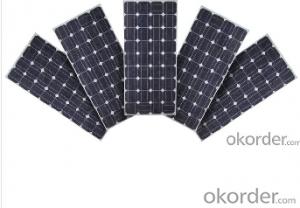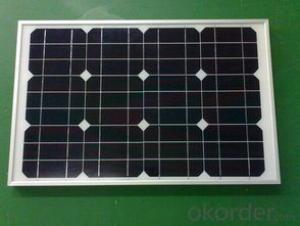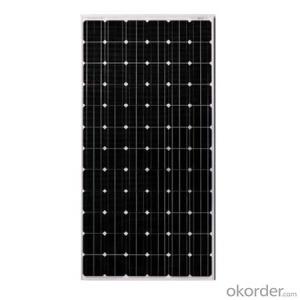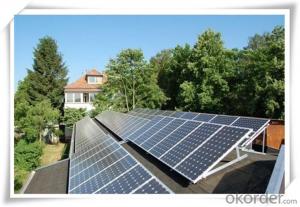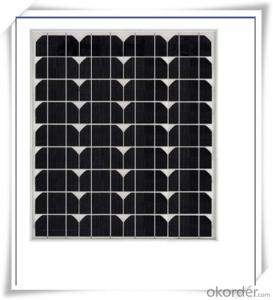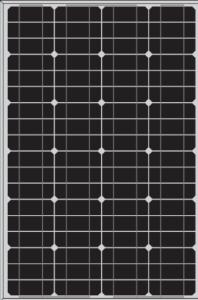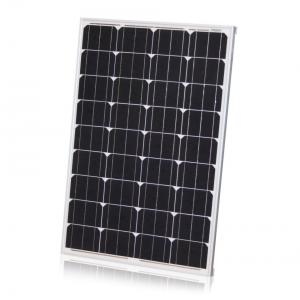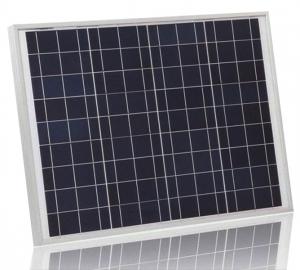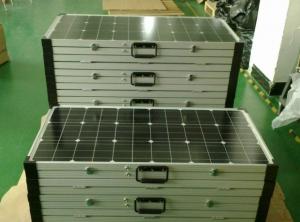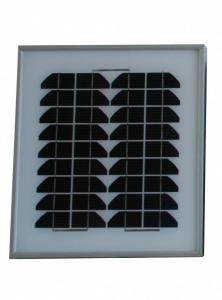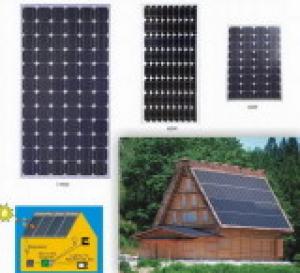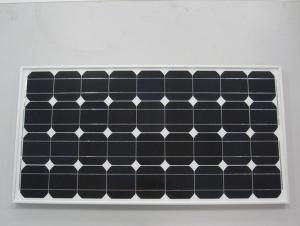Auxin Solar Panels:Factory Price 10W to 185W Monocrystalline Solar Panel CNBM
- Loading Port:
- Qingdao
- Payment Terms:
- TT OR LC
- Min Order Qty:
- 10 set
- Supply Capability:
- 300000 set/month
OKorder Service Pledge
OKorder Financial Service
You Might Also Like
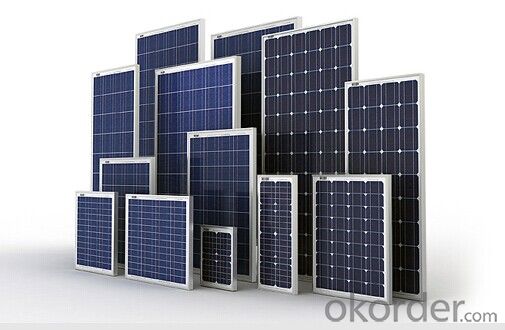
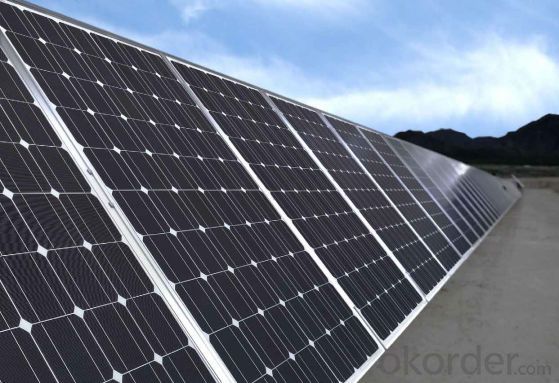
Monocrystalline Solar Modules
We offers a range of small, medium and large monocrystalline solar modules, designed for a range of requirements.
Specifications:
Tolerance | +/- 3% |
Cell | Monocrystalline silicon solar cells |
N0. of Cells | 72 (12 x 6) |
Dimension of Modules (mm) | 1581 x 809 x 40 |
Weight (kg) | 15.5 |
Limits:
Operating Temperature | -40~+85? |
Storage Temperature | -40~+85? |
Maximum System Voltage | 1000 VDC max. |
Hail Impact | Diameter of 28mm with impact speed of 86km/h |
Temperature and Coefficients:
NOCT | 48C+/-2? |
Voltage temperature coefficient (%/K) | -0.34 |
Current temperature coefficient (%/K) | 0.09 |
Power temperature coefficient (%/K) | -0.37 |
Characteristics:
Model: | SGM-160D | SGM-165D | SGM-170D |
Max-power voltage Vmp (V) | 34.5 | 35.4 | 35.8 |
Max-power current Imp (A) | 4.64 | 4.66 | 4.75 |
Open-circuit voltage Voc (V) | 41.75 | 43.6 | 43.32 |
Short-Circuit Current Isc (A) | 5.32 | 5.08 | 5.38 |
Max-power Pm(W) | 160 | 165 | 170 |
Model: | SGM-175D | SGM-180D | SGM-185D |
Max-power voltage Vmp (V) | 36.1 | 36.2 | 36.2 |
Max-power current Imp (A) | 4.85 | 4.97 | 5.11 |
Open-circuit voltage Voc (V) | 43.68 | 43.8 | 44.8 |
Short-Circuit Current Isc (A) | 5.49 | 5.48 | 5.51 |
Max-power Pm(W) | 175 | 180 | 185 |
STC: Irradiance 1000W/m2, Module temperature 25?, AM=1.5
Monocrystalline Solar Panels Specifications Range
Maximum Power (Pm) | Dimension | Weight | Operating Voltage (Vmp) | Operating Current (Imp) | Open Circuit Voltage (Voc) | Short Circuit Current (Isc) |
3W | 158x241x25mm | 0.5kg | 8.5V | 0.36A | 10.5V | 0.4A |
4W | 308x166x25mm | 0.77kg | 8.5V | 0.47A | 10.5V | 0.54A |
4W | 308.x166x25mm | 0.77kg | 16.8V | 0.24A | 21V | 0.27A |
5W | 296x215x25mm | 0.3kg | 16.8V | 0.48a | 21V | 0.54A |
10W | 286x406x25mm | 1.5kg | 16.8V | 0.59A | 21V | 0.66A |
12W | 286x406x25mm | 1.5kg | 16.8V | 0.71A | 21V | 0.8A |
14W | 286x541x25mm | 2kg | 16.8V | 0.83A | 21V | 0.96A |
16W | 286x541x25mm | 2kg | 17.2V | 0.93A | 21.5V | 0.99A |
18W | 296x541x25mm | 2.4kg | 18.8V | 1.07A | 21V | 1.2A |
20W | 296x641x25mm | 2.4kg | 17.2V | 1.15A | 21.5V | 1.24A |
24W | 541x451x25mm | 3.15kg | 16.8V | 1.14A | 21V | 1.56A |
26W | 541x451x25mm | 3.15kg | 17.2V | 1.51A | 21.5V | 1.63A |
30W | 296x966x25mm | 3.85kg | 16.8V | 1.78A | 21V | 2.03A |
36W | 541x641x35mm | 4.7kg | 16.8V | 2.14a | 21V | 2.4A |
40W | 541x641x35mm | 4.7kg | 17.2V | 2.33A | 21.5V | 2.5A |
55W | 1057x457x35mm | 6.6kg | 17.6V | 3.12A | 21.6V | 3.3A |
70W | 546x1196x35mm | 8.5kg | 16.8V | 4.15A | 21V | 4.7A |
75W | 546x1196x35mm | 8.5kg | 17.2V | 4.36A | 21.5V | 4.8A |
80W | 546x1196x35mm | 8.5kg | 17.6V | 4.55A | 21.6V | 4.9A |
110W | 1066x811x40mm | 11.8kg | 17.6V | 6.25A | 21.6V | 6.6A |
150W | 1066x811x40mm | 14kg | 34.4V | 4.36A | 43.2V | 4.7A |
- Q: I am curious about how much of the energy that a solar panel of a given size and capacity will produce in it's lifetime, and what fraction of that energy was required to produce it in the first place?
- The attached link is to an article from the 200 Home Power magazine. In that article the energy payback was found to be between 2 and 4 years. Newer panels are more efficient primarily because the silicon wafers used today are thinner. The silicon cell embodies most of the energy required to make a solar panel. Today most solar panels will produce the amount of energy required to manufacture them in between about 9 months and 2 years depending upon the specific technology used to make it. Solar panels are expected to produce energy for between 30 and 50 years. Therefore it takes around 5% of their total energy production to produce them. Note that these figures depend upon where the panels are installed. Panels in very sunny areas may generate more than 3 times the energy of panels in a cloudier area. Edit - The energy payback meta-study that carbonates references below mention one particular study Alsema (2000), which the authors used as a baseline to come up with their 4 year payback figure. These studies DO NOT assume ideal conditions. The Alsema study assumes an annual an irradiation of 700 kWh/m2/yr. That is the United States average irradiation and does take into account cloudy weather and the like. Under idea conditions the amount of energy collected can be almost twice as much. Albuquerque New Mexico is an example. The figures I mentioned above are recent values reported by several different panel manufacturers with whom I discussed the issue at the 2006 IEEE 4th World Conference on Photovoltaic Energy Conversion held this May. The very long payback times that carbonate highlights are almost certainly wrong. The study he references concludes that paybacks range between 2 and 8 years with 4 years being the most likely. In my opinion payback times are actually a fair bit shorter based on conversations with the manufacturers.
- Q: My house uses 500 kw a month, air conditioning is the main consumer, is it possible to install solar panels in my roof to produce this amount, and aproximate cost, thanks .
- I assume you mean 500 KWH (Kilowatt Hours) A good panel may produce about 00Watts. It will cover about 2SQ FT. Lets say you have a ranch style house that is 2000 SQ FT. That means if you covered your entire roof with panels, you could get about 65 panels on the roof(Not really, because you need room to get around them. Lets say practically you could get 00 panels on the roof. You could produce 00X00, or 0,000 Watts/hour (0 KW/HR)when the sun is at peak. Each hour you would produce 0 KW HR's. Lets say your area is perfect and the sun shines bright 0 hours a day, so You could potentially produce 00 KW HRS. There are losses envolved in the wiring, Battery Charger, Storage Batteries, and rectifier-controller. Maybe more realistically you could get 70 KW HRS per day. Maybe you could get 500 KWH in about 2 days. Each panel will cost about $500-$700. Panels alone will be over $50,000. The entire system installed about $00,000. This should cover your electric at least during sunny times. If you live outside of Arizona, lots of luck. Still much cheaper to ude the grid.
- Q: Can solar panels be used for powering Wi-Fi networks?
- Yes, solar panels can be used to power Wi-Fi networks. Solar panels convert sunlight into electricity, which can then be used to power various devices, including Wi-Fi routers. This allows for the establishment of Wi-Fi networks in remote locations or areas with limited access to electricity grids. Additionally, solar-powered Wi-Fi networks are environmentally friendly and sustainable.
- Q: Can solar panels be installed on schools or universities?
- Yes, solar panels can be installed on schools or universities. In fact, many educational institutions around the world are increasingly adopting solar energy systems to reduce their carbon footprint, lower energy costs, and provide hands-on learning opportunities for students about renewable energy. Installing solar panels on schools and universities can not only help them become more sustainable but also serve as a powerful educational tool for students and the broader community.
- Q: how fast does a 25watt solar panel generate power to a battery? trying to figure out a conversion factor here to get a rough estimate of how many i would need to power my house, please help?
- how fast? what does speed have to do with? Electricity travels at close to the speed of light. A house requires kW at a minimum, and 2 to 5 kW at peaks. You can do the division, 5000/25 = 40. Plus, solar panels operate only 4 to 8 hours a day in the winter, so you need to multiply that number by about at least 6 to allow for the dark hours. .
- Q: Can solar panels be installed on water pumps?
- Yes, solar panels can be installed on water pumps. This allows the pumps to operate using renewable energy from the sun, providing an eco-friendly and cost-effective solution for pumping water.
- Q: I need help?!!
- benefit- It makes use of the Suns organic engery to produce potential for a house/employer which saves money as against employing potential from the community materials for electricity. it will keep away from lots of money in case you reside in an area that is sunny a super style of the year. disadvantage- You extra suitable wish that is sunny for a on an identical time as to construct a inventory pile of potential. It somewhat relies upon on your desires for potential, in case you do no longer use incredibly some it and stay in a sunny section a super style of the year, then you incredibly could desire to have a super style of potential that only kinda sits there. yet once you reside in an area it somewhat is frequently cloudy all year around then image voltaic panels does no longer be superb for you.
- Q: Can solar panels be used in areas with high levels of snowfall?
- Yes, solar panels can still be used in areas with high levels of snowfall. While snow accumulation on the panels can temporarily reduce their efficiency, modern solar panel designs and technologies have improved to withstand heavy snow loads. Additionally, the angle at which solar panels are installed and their smooth surface can help snow easily slide off, allowing them to continue generating electricity even in snowy conditions.
- Q: Hi, I bought 50 6X6 inch solar cells, I also bought a 40 amp diode, I still need to buy a battery, and inverter and a voltage controller, could you tell answer me the following questions:) I would like t build a small panel at first, (may be 0 X 0 inch), with that I would like (or at least to try) to power my laptop for the hole day, so I wont receive a very high amperage, yet, all the inverters I saw at e-bay are rated over 400 amp, if I buy a 400 amp inverter, can I use it with such a small amperage?2) what about buying a small car inverter, will it work?3) suggestion about the battery and the voltage controller will be kindly appreciated.Thanks
- I'm guessing that each of those solar cells is just 0.5 volt at max power, so if you make a 2-inch square panel, you will get 2 volts - not enough for the inverter. A car inverter is notoriously inefficient, but it would work if you connect it to a 2-volt battery. You cannot generally connect such an inverter to solar panels alone. The battery supplies the peak current that the inverter needs, and the panel charges the battery. To charge a 2-volt battery, you will want 36 cells, generally, which give you an 8-volt panel. You can buy an inexpensive charge controller somewhere. If your laptop will run off 2 volts directly, you can skip the inverter and be much more efficient. Or if the laptop runs of (say) 9 volts, you can use about 40 cells to get 20 volts, get the proper power plug from Radio Shack, and plug the panel directly into the laptop.
- Q: How do solar panels affect the roof's structure and integrity?
- Solar panels can have a minimal impact on the roof's structure and integrity. When properly installed, solar panels do not pose a significant risk to the roof. However, it is important to ensure that the installation is done by professionals who follow industry standards and guidelines to avoid any potential issues such as leaks or damage to the roof. Additionally, the added weight of the panels should be considered, but modern mounting systems are designed to distribute the weight evenly, minimizing any strain on the roof.
Send your message to us
Auxin Solar Panels:Factory Price 10W to 185W Monocrystalline Solar Panel CNBM
- Loading Port:
- Qingdao
- Payment Terms:
- TT OR LC
- Min Order Qty:
- 10 set
- Supply Capability:
- 300000 set/month
OKorder Service Pledge
OKorder Financial Service
Similar products
Hot products
Hot Searches
Related keywords
